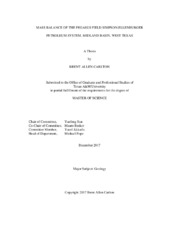| dc.description.abstract | As demand for sustainable energy increases, earth scientists seek to meet this demand by economically producing hydrocarbons from petroleum systems. Petroleum systems are complex, therefore multidisciplinary basin modeling analyses are used to gain more information about their dynamic nature. In this study, a mass balance workflow is developed and implemented to identify the quality and quantity of hydrocarbons distributed throughout the Pegasus Field Simpson-Ellenburger petroleum system. Four hypotheses are tested in this analysis which include the variation of hydrocarbon migration direction, alteration of source rock richness, and modification of generation kinetics. Post-testing analyses will also identify the geologic processes and parameters that have the largest impact on modeled results.
Modeled results indicate approximately 400 million barrels of condensate oil are in place within the Pegasus Field Ellenburger reservoir. Variation of hydrocarbon expulsion and migration directions result in two possible methods for charging the Ellenburger trap. Downward vertical charge from the Simpson Group delivers enough hydrocarbon fluids to match oil in place estimates, but final oil API gravities are slightly higher than measured data. Similarly, horizontal intraformational charge from the Simpson Group also delivers enough hydrocarbon fluids to match oil in place estimates, but final oil densities are slightly higher than measured data. When more optimistic source rock richness values are applied, the volume of generated and expelled hydrocarbons compared to previous tests increase by a factor of 1.5 which provides more than enough hydrocarbon volumes to match oil in place approximations. Final modeled API gravity are slightly lower compared to produce fluids. When hydrocarbon generation kinetics are altered, 1.5 times the amount of oil and significantly larger gas volumes are retained within the source rock. Expelled hydrocarbon values are reduced, yet the model suggests enough hydrocarbons are expelled to match oil in place approximations. Alteration of generation kinetics result in a final mixed oil API gravity that is lower compared measured data.
Seal formation, migration and accumulation, burial history, and timing of geologic events are the most critical geologic processes impacting the petroleum system. Critical parameters include source rock richness, thermal history, source rock generation kinetics, and migration fetch area. | en |


